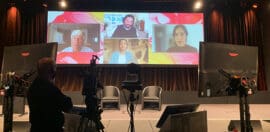Lessons from Interface

31 May 2022 at 4:36 pm
Interface Australia and New Zealand managing director Rob Coombs reflects on the company’s journey to beyond zero and how times have changed.
Back when Interface first made the decision to become a sustainable organisation, talking about sustainability was not a way to boost share price, nor was it safe to mention to investors.
Today, the company’s sustainability credentials are included in every investor communication.
It is a sign of how far the conversation has come around the business imperative to reduce environmental impact and act sustainably.
It is also a testament to the journey Interface has been on.
Starting in 1994, the carpet tile manufacturer set out to achieve “mission zero”. Armed with a 25-year business plan, the aim was to reach zero emission targets by 2020.
True to its word, it became the first global flooring manufacturer to sell all of its products as carbon neutral across their full life cycle.
The story of how it did this – under the leadership of the company’s visionary founder, the late Ray Anderson – is captured in the documentary Beyond Zero.
See our interview with director Nathan Havey to find out why he brought the story to the screen.
At a recent screening hosted by Shared Value Project, Interface Australia and New Zealand managing director Rob Coombs spoke to audiences about the quest to eliminate the company’s negative impact on the environment and how times have changed.
Coombs, who has been at Interface for 30 years and was there at the beginning of the sustainability journey, said back then they understood the moral imperative, but it took them some time to connect that to a business imperative.
“Where this really got traction within the company was when we all realised that this wasn’t just something you did at the end of the day after you finish your day job. This actually could be integral to a much more successful organisation in a whole range of fairly traditional ways,” Coombs said.
“We used to say, if you stood in front of your average chief financial officer and said, ‘I’ve got a program here which can lower your costs, can lead to a much better product design, can lead you to many more customers, can increase your profitability, and can attract and retain fantastic people’, would [they] take it? That’s when we started to see what this could be.”
He credits Anderson’s leadership with keeping the company on mission – admitting that in the beginning, the company was “following Ray pretty blindly”.
“Of course, you wanted to believe. It was a noble thought that you could actually transform the business in this way and have a much wider impact, in a very beneficial sense. But, you know, this is not the path of least resistance, and it still isn’t,” Coombs reflected.
“You need that leadership drive. And we were very lucky to have Ray, of course, in that role.
“I think if you look at many organisations that have made some progress here, you find them being led by founders or those that have been involved in the founding of the business. And you know, you had in Ray someone at the age of 62, very focused on his legacy. And I think that’s a lot of what drove him and in turn drove us.”
What made the journey a success however was that everyone in the organisation, from the top down, got on board with the mission. Coombs remarked that while there have been changes in leadership over the years it has been clear to anyone coming in that they need to carry the mission forward or they will be rejected by the team.
This focus on sustainability has also driven a strong culture of innovation across the organisation.
But while in the beginning, Interface’s mission zero was something that set them apart. Coombs said their competitive advantage has been reduced in recent years, as more and more businesses have realised you can do business in a more sustainable way, and succeed.
“There’s no doubt that the gap between ourselves and our competition is nowhere near as big now as it was back then, because our competitors are working hard to match what we’re doing. And that’s a really good thing,” he said.
He also acknowledged that being a sustainable company doesn’t automatically equate to fantastic business outcomes – it doesn’t stop you from making bad decisions, from appointing the wrong people, or from making bad acquisitions.
“And we’ve gone through a mass of that over the years,” he said.
He admitted that despite the company’s successes, there were still areas to improve.
“We are less strong on the social side than we are on the environmental side. And we’re sort of working hard to bridge that gap,” he said.
“Ray was very energised by planetary restoration. He was less energised by social engagement, inclusion, diversity, and so on. So we are playing a little bit of catch up there in a way that doesn’t feel comfortable.”
He said there was also now an understanding across the industry that there are a range of issues, particularly around the circular economy, which no one individual company can solve alone.
This has sparked what Coombs deemed “some pretty radical collaboration” across supply chains and with competitors in the market to make progress on an industry-wide basis.
“So I think it’s morphing from that sort of competitive focus to, at least in some areas, recognition that you have to think in a completely different way within your space, within your market, in order to solve some of these really critical problems,” he said.
With an eye on the future, Coombs said the current focus for the company is going beyond zero, to carbon negative.
“So ‘Mission Zero’ was our mantra for 20 years. ‘Climate takeback’ is our mantra as of five years ago. [We’re] looking to develop products, and looking to develop processes, that actively take back carbon from where it shouldn’t be, to where it should be,” he said.
“So we launched a range of products, that is such that there’s less carbon in the atmosphere at the end of the process than it was when we started to make it.
“[We’re also] focused on ensuring that the carbon footprint reduction that we’re making moves beyond factories, beyond the product, to the wider organisation as a whole, and then we’re really focused on this circular economy challenge, which I think is the most difficult.”
If you’re interested in hosting your own screening of Beyond Zero with staff or stakeholders, reach out to Cerisse Denhardt at the Shared Value Project: cdenhardt@sharedvalue.org.au.







